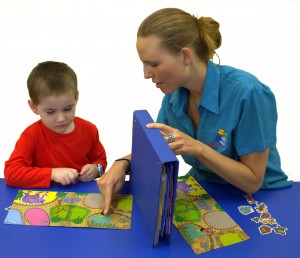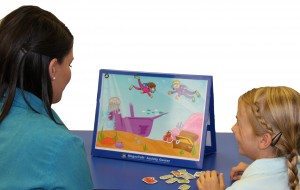
Speech pathologists love barrier games and they are great for parents, teachers, support workers and child care workers too, really anyone who works with children. Barrier games are a fun way to develop listening skills, oral language skills, social language skills, clear talking and understanding of concepts. They are great for extending the amount of information your child can understand or express within a sentence.
Barrier games are fun, cooperative, flexible, portable and inexpensive. They are easy to adjust to different children's skill levels and to make more complex as a child progresses. They can be varied to suit a wide range of age groups and can be used with one child, in a pair or with a group.Here are ten different ways that you can use barrier games to target different skills and some free downloads as well!
Barrier games require a listener, a speaker, two identical sets of materials and a barrier such as a large book that will stand up. The barrier is placed between the two players so that each cannot see the others materials. The speaker then arranges his materials and describes to the listener what they are doing. The listener arranges their materials in the same way.
Your speech pathologist can supply you with picture sets to use and there are links throughout this blog of picture sets that you can download and print. Once you know what to do with the picture sets it is easy to use other materials as well. Materials can include blocks, Lego, miniature objects, animals and figures, sticker sets, picture cards from games, coloured pencils and paper, real objects, maths materials, collage materials.

Here's how to use the picture sets:
- Print and laminate the sheets, with a set for each person. Leave the background sheet, or large pictures as a full page and cut up the small pictures into individual pieces. Each player should have one background sheet and one set of small pictures. You will also need a barrier such as a large book or folder.
- Next sit facing each other. Set down the background sheet and lay out the small pictures so that your child can see all of their pictures. Place your own background sheet and small pictures in front of yourself.
- Check that your child knows the names of all the small pictures. If there are any they do not not know remove them or teach the word to your child.
- Explain to your child that you are going to play a game to see that you are good listeners and talkers. Explain that you will put your pictures onto the background and tell the child what to do to make their picture look the same as yours. Tell them that they need to listen carefully, because they will not be able to see what you are doing. Stand up the barrier and explain that this is so that the child cannot see what you are doing and needs to listen carefully.
- Place your small pictures on the background one at a time and give your child clear instructions about how to put their pictures in the same position as you go. Make sure you give your child enough time to respond before giving the next instruction.
- When you have placed all the pictures on the background take the barrier away and talk to your child about the pictures that they have placed in the correct position. Explain to them that this means they have listened carefully. Explain the correct position of any pictures that the child may not have placed correctly.
- Play the game again and this time, tell your child that it is their turn to talk. Explain that you will listen carefully and make your pictures look the same as theirs. Put the barrier up again and ask the child to tell you where to put the pictures. If your child’s instructions are not clear, you may need to cue them such as if your child says “put the car there” you might say “I've got the car, but I'm not sure where to put it”.
- Take the barrier away and look at all the pictures that are correctly positioned and tell your child how this means that they did a good job of talking and that you listened carefully. Talk about any pictures that are in the incorrect position. Model the correct instruction such as “oh, I needed to put the cat under the tree”.
Once your child understands how to play barrier games, you can use a range of items from around the house to make your own games. You can use cut out pictures, from catalogues or clip art, objects and small toys from around the house, and toy or sticker sets from “cheap shops”. You can gradually make a game more difficult by increasing the length and complexity of the instructions, and the number of items that need to be placed. You can introduce concepts of space such as: in, on, under, next to, above and below. You can also introduce concepts of colour and size.

Here are five ways that you can use barrier games to develop communication skills:
1. Listening and auditory memory. To develop listening and auditory memory skills you need to begin with an instruction that your child can follow easily and gradually increase the length of the instructions. Begin with a simple barrier game and give your child some instructions with two key words such as "put the dog in the car". If your child can do this repeat five similar two word instructions and note how many they get exactly right without any help. If four or five of five turns are correct try three key words "put the cat and the dog in the car". If these are mostly correct try four "put the cat in the truck and the dog in the car". You want to work where your child is getting some correct, but not all, say two or three out of five. If your child can do four key words consistently add some concept words as in part three below and keep counting key words until you find the level to work at.
There are more ideas and activities for developing skills with following instructions here. You can print two copies of the following instructions activities to turn them into barrier games. There is more information about developing listening and following instructions here.
2. Extending sentence length. To extend your child's sentence length you can work through the number of key words your child can do as above but get your child to tell you what to do with the pictures. So first ask them where to put one picture, then two and so on. Practice at a level where your child needs a little help but not too much and gradually add an extra word as they get more skilled and confident. If your child finds it hard to form the sentences taking turns can help, 'I'll tell you then you tell me' because you can model for your child how to make the sentences. If your child has a go but makes some mistakes model say their sentence back to them the right way but be encouraging and positive.
Here are some simple barrier games for practicing both listening and forming longer sentences.
3. Developing vocabulary. Barrier games are great for practicing vocabulary. For younger children begin with games where they know most of the words and add a few new ones. Start with your child listening and then work to them using the words to tell you what to do. Barrier games are also great for familiarising preschool children with vocabulary for themes at pre-school or school. If your child is going to be learning about dinosaurs or Africa or insects why not make a barrier game and use this to practice the vocabulary your child will be needing to understand and use. The more familiar these words are the easier learning will be, the more confident our child will feel and the more information your child will remember. Ask your child's teacher for a word list and use Google images to find some pictures to use. For more information about developing vocabulary and some lotto games that can make simple barrier games click here.
4. Developing understanding and use of concepts. Once your child knows how to do barrier games, can follow simple instructions with at least three key words, and form simple sentences, you can begin to add some concepts such as size, colour and position words to your games. Remember to keep in mind how many key words your child can understand and that the concept words count too. Put the big pig in the truck would be three key words. Put the big pig under the truck would be four, because you need to pay attention to the position word as well. Here are some pictures you can use in your games to practice colour and size concepts. For more information on developing concepts click here and you can also download some games for developing position words. Print two copies to make barrier games!
5. Developing descriptive language. As your child's skills develop you can use barrier games to develop descriptive language. One fun and easy way to do this is to make a rule that you cannot say the names of the pictures, so to "put the dog on the boat" you might have to say "put the brown animal that barks on the blue vehicle that goes in the water". Another way it to use more complex materials. There are some more complex barrier games to print off here. A way to really challenge those descriptive skills is to use three dimensional materials such as blocks or objects such as plastic animals. This requires much more careful description to place the items in the correct spots. You can begin by placing items such as plastic animals onto a printed board such as the one from the farm game, then move to using other objects such as trees, fences or blocks to form the background instead of the printed sheet. Drawing is also challenging. You might start with a grid as a background to help with positioning them move to a blank page as your child becomes more skilled. Here are some more ideas for developing descriptive language.
Variations on barrier games. Rather than one speaker and one listener, two people can take turns giving the instructions. This is a good way to support beginners. If you are working with groups of children you can play barrier games in a group. The children can sit in a half circle and one child sits with their back to the rest of the group and gives the instructions. Alternatively, children can take turns giving one instruction each. You can do barrier games as a whole class activity using photocopied background boards and instructions which involve drawing, pasting or colouring on the sheets.
We hope you and your child have lots of fun with barrier games. Check back next fortnight ( next week will be an occupational therapy topic) for five more ways to use barrier games with some more links and downloads for:
6. Developing grammar skills
7. Transferring new speech sounds to conversation
8. Developing clearer speech
9. Developing theory of mind
10. Developing written language
Why not follow so you don't miss out!
To find out more about how the
Related Blog Posts
If you liked this post you may also like:
Using OPERATION To Grow
10 speech tips
Good Winning and Losing Behaviour
Now let's play



